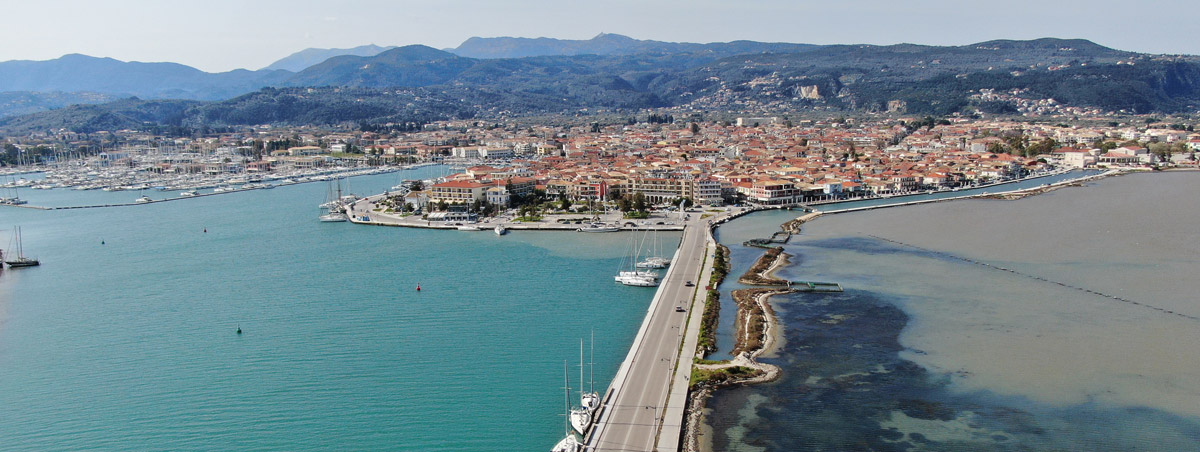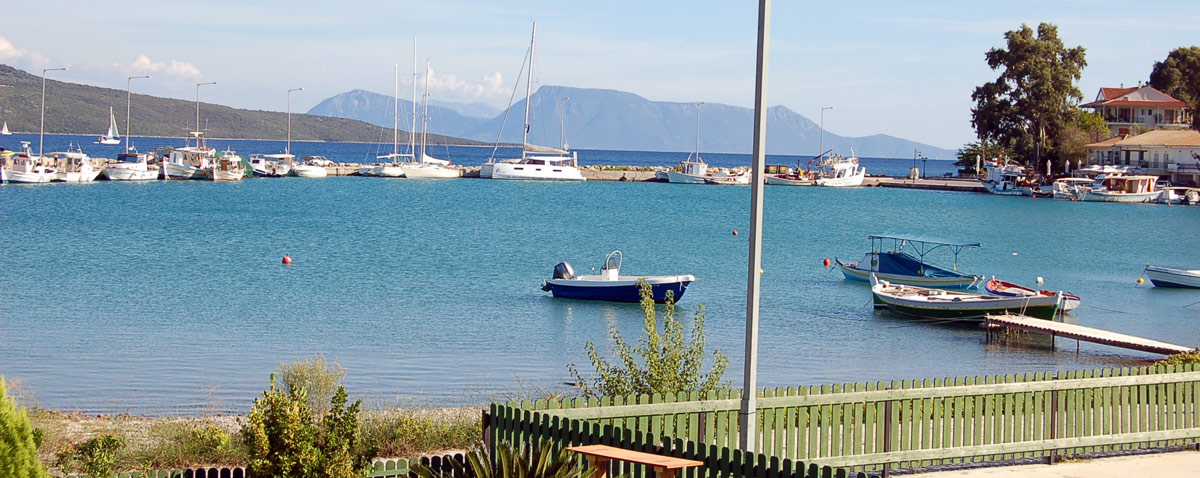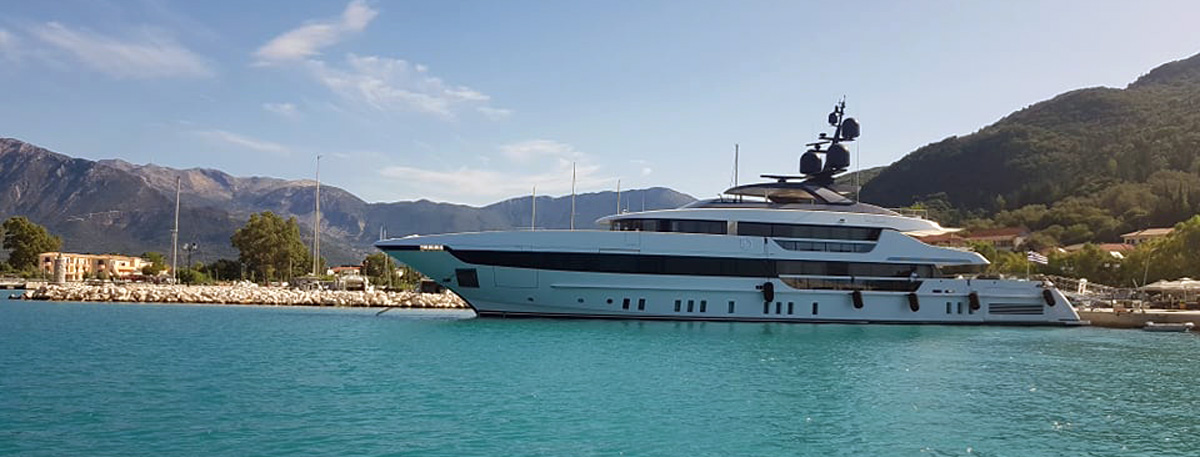
It is the island that, as Homer says, “almost touches” the opposite Aitoloakarnania of mainland Greece. In the Drepano Strait there is a floating bridge about 25 meters long that connects the island with the opposite mainland. Together with Evia, it is the only two islands in Greece that can be accessed by road.
It seems to have taken its name from the white colour of its rocks. Cape Lefkata, located at the southern tip of the island, was called “Lefka’s Stone” in ancient times, and is believed to have given its name to the island.
There are archaeological finds that testify to the presence of people on the island starting from the Neolithic era, according to findings in Frini (Asvotrypa) and in the cave of Choirotrypa, near the capital of the island. During the archaic and classical times, sanctuaries of Pan and nymphs were built in Asvotrypa and on the peninsula of Agia Kyriaki. Also found were 30 circular tumuli with many grave goods, which indicate that there was a settlement from the Bronze Age outside Nydri, and two cemeteries in the town of Lefkada, one in the south (at Karyotes) and one in the north (at Tsechlimpou), which reveal the prosperity of an ancient city until Hellenistic times. The city was protected by a wall which ended in the sea near the salt pans and parts of it can be found on the hill of Koulmos.
Lefkada was founded as a colony of the Corinthians and some Corfiots in the seventh century BC. It seems to have allied with Sparta in the Peloponnesian War and later supported Alexander the Great’s campaign, hence the founding of cities of the same name in Syria and Damascus.
In Byzantine times the island was called Agia Mavra. This was the name of the church built in the castle of the same name, which was a model of fortification art, built by the Sicilian John Orsini. For a long period of time, while the city was held by the Turks, the city expanded around this castle. The Turks added a large arched bridge with 360 arches, on which they even supported the pipes of an aqueduct that brought water to the castle. Several years later, the bridge was destroyed by earthquakes and some traces of it are still preserved in the lagoon.
When the Venetians conquered the island, they moved the town to its present location opposite the castle. The Venetians recognized and allowed the island some administrative autonomy, creating local governments, but this did not mean the lack of influence of Venetian elements on the infrastructure and lifestyle of the islanders.
France quite later, under Napoleon, occupied Lefkada, as well as the rest of the Ionian Islands. The economic measures of the French could not be tolerated by the Lefkadians, who became resentful. The Russo-Turks later took over the Ionian Islands. From them the sovereignty passed to the English to be finally ceded to the Greeks. After the Asia Minor disaster, Lefkada received around 5,000 refugees.
The town of Lefkada, the capital of the island, is surrounded by the channel and the lagoon, while further north is the thin circular line of the sandy beach of Gyra with its few trees and mills. In the capital, which is also a port, one can visit the Bosketo Park, with its busts of the island’s famous personalities. In the area of Kouzoudeli, it is also worth seeing the century-old plane trees and drinking coffee in the traditional cafes that serve not only coffee but also soumada made from almonds. The Archaeological Museum is also noteworthy, with findings from the Middle Paleolithic era to the 4th century AD from burial mounds in Nydri and the cemeteries of the ancient city of Lefkada.
On cape Dukato (or Lefkata), a short distance from the settlement of Athani, at the site of the present lighthouse, 60 metres above the sea, the sanctuary of Apollo was built in antiquity, where sacrifices were made to appease the gods. This location, with its steep cliffs and view of the sea, is referred to as ‘Sappho’s Piedmont’ and later ‘Lady’s cape’, because, according to tradition, this is where the lyrical poetess committed suicide.
Apart from the Kavos, a romantic destination is the waterfalls in Dimosari. From 12-metre-high rocks, water falls with force into a lake. Although they are only four kilometers from the sea near Nidri, it does not resemble an island landscape at all but more like a continental landscape. The flora and fauna is also very interesting, not only around the waterfall, but also in various other places on the island such as the wetlands. 12 wetlands have been recorded. Some with fresh water, others with brackish water and others only with salt water. The island is included in the Ramsar Convention.
Apart from the wetlands in the northeast of the town of Lefkada, there is a unique, historically, living environmental monument, the centuries-old Venetian olive groves. It consists of old olive trees planted by the Venetians when they occupied the island in order to turn the Lefkadians from the sea to agriculture.
Lovers of water sports will find beaches suitable for them. On the beach of Agios Ioannis and its continuation, at Milios, one can get in touch with the sport of kitesurfing. Agios Ioannis is a sandy beach on the western side of the island and very close to the town of Lefkada. The old windmills there make the landscape very picturesque. In the bay of Vasiliki, at Ponti beach, one will find ideal conditions for windsurfing. Both beaches are among the three most suitable in Europe and among the ten best in the world for such sports. The more adventurous will enjoy a paragliding flight to Kathisma, one of the most beautiful beaches. Or, they can even fly in the planes of the Lefkada Aero Athletes Club. Kathisma beach is the continuation of Agios Nikitas beach. The beach is beautiful, long and sandy and protected by rocks. Agios Nikitas or Pefkoulia is a small beach located near the village of Agios Nikitas. It is one of the most beautiful beaches of the island, with deep blue waters, sand and pebbles. It is long, but there are currents, so care is needed. Mylos beach is located in the homonymous bay. Access to the bay is possible by boat from Agios Nikitas. The sea is steep, so it is not ideal for weak swimmers and children need constant supervision. Perhaps the most impressive beach of Lefkada is Porto Katsiki because of the landscape with the steep cliffs that surround it. It can be reached by descending the steps on the rocks or by boat from the villages of Vasiliki and Nidri. Another beach that is difficult to reach without a boat is Egremni. The beach is long and sandy and the steep rocks around it make the landscape unique.
Lefkada has a rich cultural life. The Philharmonic Society of Lefkada (FEL), which is the second oldest musical society in Greece, has contributed to the cultural heritage of the place. The re-enactment of the Peasant Wedding in Karya and the Faki Festival on the plateau of Agios Donatos in Egklouvi are also two of the island’s cultural events. Also a big festival is held every year on May 3 on the feast of the patron saint of Lefkada, Agia Maura, around the homonymous chapel of the town.
Surrounded by 24 islands, Lefkada is a paradise for those who visit it by any watercraft.

Lygia
Lygia is located on the eastern coast of the island. It has a small harbour for the island’s fishing boats or pleasure boats. Karyotes and Lygia are the first seaside settlements that one meets when leaving the town of Lefkada, in fact one settlement is a continuation of the other. The beach has coarse pebbles. The area is full of small and large beaches where the vegetation reaches the sea. Lygia is the second largest fishing centre in western Greece and operates one of the most important fish scales with many fishing boats and seiners.
At a distance of 3 km from Lygia is Katouna. It is a traditional settlement with old houses and a beautiful little square in the centre of the village. It is worth visiting the two churches, Panagia with its beautiful bell tower, and Agios Varvaros with its old temple and its wonderful icons.
Nikiána
Nikiana is located between Lygia and Nidri, on the eastern side of Lefkada. Before settling in Nikiana, the first inhabitants lived in the mountain villages Alexandros and Kolyvatas, located on the top of the mountain of Skara. Nikiana is preferred by many boat owners because it has a picturesque and sheltered harbour with a boat launching area.
Around the settlement of Nikiana there are some small and larger beaches. The area is suitable for families with children and elderly people because the access is very easy, the waters are shallower than the western beaches and the presence of trees creates a natural shade. Among these beaches, the beach of Limni, at the entrance of Nikiana, stands out, with fine sand and shallow waters. Next to it is the small beach of Kontria with white pebbles, next to the port of the village, named after the large rocks or “kontria”, as the villagers used to call them.
Nydrí
There are archaeologists who claim that the area was the capital of the island of Odysseus and Homer’s Ithaca. Excavations were carried out in the area and the circular tombs of the Early and early Middle Bronze Age were found, but no findings were found to prove the existence of the palace of Odysseus. The area of the Nidrios plain up to the south-eastern slopes of Mount Skaros has been declared an archaeological site.
Opposite Nydri are the islands of Meganisi (the largest of the complex), Skorpios, Skorpidi, Sparta, Madouri, Cheloni and Tsokari, which are the ‘princely islets’ of Lefkada. The islet of Madouri (owned by the Valaoritis family) with the neoclassical mansion of Aristotle Valaoritis, and the islet of Skorpios are private. Scorpios was bought by Aristotle Onassis in 1963. This private islet was architecturally designed with every luxury and care in order to preserve its uniqueness, and it has hosted from time to time the great personalities of the time, from all over the world. In the port of Nydri there is today a statue of Onassis.
Nydri is built in a plain along the sea. The beach of Nydri is the most popular spot of the settlement, as from there one can admire the sunset.
It is also preferred by those travelling by boat on the Ionian Sea as it has a safe and modern harbour.

Vlychó
It is a seaside settlement near the cosmopolitan Nidri of Lefkada, built on the western side of a closed bay that bears its name. Opposite Vlyho is the settlement of Yeni. The village is very narrow and the houses are arranged in 2 rows along the length of the sea.
This cove, with mooring and boat service facilities, is preferred by those travelling by boat. It takes its name from the 30 bushes of the mountain of Amalis from where water gushes out.
Some historians believe that the bay was the harbour of the island of Odysseus, the port of Homer’s Ithaca.
Vlyho was the port of the village of Katochori. In the past it was an important commercial and fishing port.
The place is popular with people who come to learn sailing or have boats. Boat enthusiasts will find houses for rent with direct access to mooring facilities and concrete ramps that go from the road directly to the sea.
A challenge for every visitor is the morning walk to the village of Geni to the chapel of Agia Kyriaki. In the same area you can visit the grave of Wilhelm Dörpfeld, the German architect, archaeologist, philhellene who claimed that Odysseus’ island was Lefkada.
Sývota
It is one of the most picturesque ports of the Ionian Sea and has been characterized as a traditional settlement.
Sivota is the port of Evgeros and it is said, according to historians who believe that Lefkada is the island of Odysseus, that Eumaeus used to herd his pigs in the area and from this fact, they got their name (sys = boar boton = herd).
It is built in a natural bay, deep, resembling a fjord. Due to its geographical location, it is characterized as an ideal port and provides the possibility of docking recreational boats. Its capacity exceeds 200 boats, with the possibility of mooring even large-draft vessels. In Sivota there are some wonderful beaches with amazing waters and white sand of exceptional beauty. However, most of them are accessible only by water. One should not miss to visit the lighthouse of Cape Lefkatas. The height of its round concrete tower is 14 meters. Its focal height is 70 meters. It is believed that it was built on the ruins of an ancient sanctuary of Apollo.
The archaeologist Wilhelm Dörpfeld believed that the Phaeacians left Odysseus there while he slept and when he woke up he realized he was in his kingdom.

Vasilikí
Vasiliki is the second largest tourist centre of the island after Nydri. It is the main village in the area of southern Lefkada, which was originally inhabited by residents of the surrounding mountain villages. The bay of Vasiliki is located between Cape Lefkata in the west and Cape Lipso in the east.
It is said that it got its name from a princess who came by boat to meet her lover. Because of the great sea turbulence, the boat she was on sank and she lost her life. The name Vasiliki was given in honor of the princess in the area.
From Vasiliki, tourist boats depart for the world-famous beaches of Porto Katsiki and Egremni, which are located in a secluded location in the southwest of the island and are considerably more inaccessible from the mainland.
The beach is pebbly outside but inside it quickly becomes sandy and the waters are shallow. The large sheltered bay of the village to the west along the beach is called Ponti and is considered one of the best in the Mediterranean for the sport of windsurfing, as it has special wind conditions. The bay is famous for the midday wind called Eric, which blows at 30-40 miles per hour. Thanks to such ideal natural conditions, Vasiliki is one of the ten best beaches in the world for windsurfing.
From the harbour of the village there is a daily ferry connection to Kefalonia (Fiskardo) and Ithaca (Frikes and Pisaeto), but also to the neighbouring beach, east in the bay, the beach of Agiofylion.




